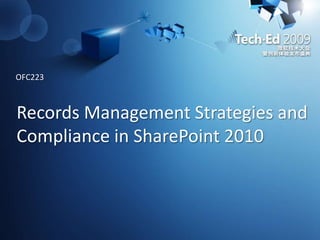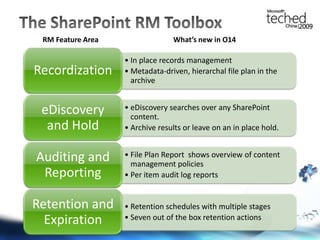Records Management strategy and compliance in SharePoint
- 2. Records Management Strategies and Compliance in SharePoint 2010OFC223
- 3. Session Objectives & TakeawaysSession Flow:Approach & Tools: Learn what¡¯s different about SharePoint Records Management.Demos and Best Practices: Let¡¯s solve real business problems with 2010 RMTakeaways:New customers: 2010 expands on the 2007 RM vision by removing significant roadblocks to RM deployments.Limits: There are still RM scenarios beyond what we target for SharePoint.
- 4. SharePoint 2010: Smart RMKey tenants of RM in the 2010 release:
- 5. The SharePoint RM ToolboxRM Feature AreaWhat¡¯s new in O14
- 6. Business Problem #1How do I prepare for litigation and eDiscovery?
- 7. Litigation and eDiscoveryPrimary focus should be on up front preparationAppropriately enforced retention policiesConfigure the system to track appropriate actions (auditing)Leverage existing search technology during discovery process.¡°Custodian based approach¡± to eDiscovery doesn¡¯t work in a collaborative environment.
- 8. ÑÝ Ê¾Litigation PreparednessRetention, auditing, eDiscovery search
- 10. Business Problem #2How do I protect the most important data in my enterprise?
- 11. ÑÝ Ê¾In Place Records ManagementRecord lock down, record retention polices
- 12. Workflow and RecordsDeclare Record action in SPDPolicy on the blog postsWorkflow creating recordsRecord status driving business decisions
- 13. ÑÝ Ê¾SharePoint 2010 Records CenterFile Plan Builder, File Plan Report, Metadata Based Submittal and Navigation, Stubbing
- 14. Record in 2010Choosing between In Place vs. Archive
- 15. E-Mail ArchivingExchange 14 offers alternatives to PSTs via an online archive of e-mail.Allows cheaper storage for the less frequently used contentPolicies can drive e-mail to the archive.
- 16. Business Problem #3How do I scale my compliance solution to the enterprise?
- 17. Content Type Syncing and Compliance Coordination* Content gets created using enterprise content type.* Corporate policy gets applied, regardless of where content is createdCollaborative Space(In progress content)* Records Center subscribes the service* Incoming content already has correct metadata and policy.-Enterprise Content Type & Policy Sharing Service-Enterprise MetadataRecord Center(Highly managedRepository)
- 18. ÑÝ Ê¾Policy on the blog posts, Content Type Syncing
- 19. Scale and Distributed ArchitectureTo scale to 100s of millions of records, we¡¯ll need to distribute the data to several databases and sites.O14 includes features to ensure centralized management of this distributed data:The content organizer distributes submissions across the sites.Content types are shared across site collections.Centralized eDiscovery searches across all sites.FAST Search ensures a unified retrieval experience.
- 20. ÒÉÎʺͽâ´ð






















